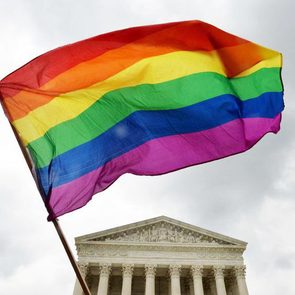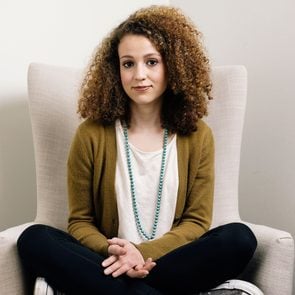What Does LGBTQ Stand For?
Updated: Jul. 09, 2024

LGBTQ is more than just a time-saving abbreviation. Here's the true LGBTQ meaning.
Although most people in the LGBTQ community can likely recite with minimal effort the words represented by each letter of the acronym, for some, the meaning of LGBTQ remains a head-scratcher. So, what is the LGBTQ meaning and what does it stand for? To understand the acronym, as seen in LGBTQ books and more, it’s important to understand the varied components of the LGBTQ community—how they’re similar and how they’re different.
The acronym brings together individuals who identify as being under the LGBTQ umbrella while also recognizing what sets them apart—both from one another and from everyone else. It’s both distinction and solidarity in five letters. To celebrate and to better understand those five letters, we spoke with Ross Murray, the senior director of the non-profit LGBTQ advocacy organization GLAAD Media Institute.
So, along with looking into LGBTQ flags and LGBTQ quotes, we hope that knowing the LGBTQ meaning will inspire you even more!
Get Reader’s Digest’s Read Up newsletter for more fun facts, holiday tips, humor, cleaning, travel and tech all week long.
About the expert
|
What does LGBTQ stand for?
So, let’s get right to it: What does LGBTQ stand for? As far as the alphabet is concerned, the LGBTQ meaning is straightforward. The individual letters represent:
- L: Lesbian
- G: Gay
- B: Bisexual
- T: Transgender
- Q: Queer (or Questioning)
You may also see the acronym written as LGBTQIA. The I and A stand for:
- I: Intersex
- A: Asexual
Although gay men have been more visible in the movement and in media, and have received most of the LGBTQ attention since the 1969 Stonewall Riots, the placement of L at the beginning of the acronym is significant and intentional. It’s a gesture of appreciation for the lesbian community, which has played a large, if sometimes overshadowed, role in the push for equality. These women stood right alongside gay men when few others would, especially in the 1980s and ’90s, as AIDS was decimating the gay community. In fact, lesbians have been among the staunchest LGBTQ activists and LGBTQ heroes.
According to Murray, “The letters are not a rank ordering, but it’s been a way of trying to recognize a group that faces an intersection of oppression, both of sexism and of homophobia.”
How did LGBTQ come to be?

The term homosexual is believed to have been coined by Hungarian journalist Karl Maria Kartbeny in the mid-19th century, but it came to be regarded as somewhat limited and even derogatory. So-called sexual orientation and sexual identity are about so much more than sex, and over time, homosexual—and especially its shortened form—fell far out of favor.
“That homosexual term was something that was used to talk about us, not us talking about ourselves,” says Murray, who cites the need for the community to distance itself from the word’s “very clinical, medicalized focus” as a determining factor in its ouster from the community’s lexicon.
Gay, a more neutral-sounding and less-loaded synonym, debuted in the Oxford English Dictionary as a slang for homosexual in 1951. By mid-decade, it had become the more socially acceptable term, for both men and women.
Meanwhile, the word lesbian, derived from the Greek island of Lesbos—whose most famous citizen, Sappho, wrote love poems to other women—became accepted as the strictly female equivalent as the feminist movement took hold in the 1970s. As gay men and women fought together for equality, it was only a matter of time before the words that described them were united as well, driving LGBTQ meaning and influence.
How has the acronym changed over time?
In the beginning, there was the word gay. It was a sort of catchall term that encompassed both men and women with same-gender sexual orientation. In the mid- to late ’80s, the short acronym LGB came into usage as an exclusive umbrella for lesbian women, gay men and bisexual people. At the end of the following decade, “T” was added to signify the inclusion of transgender people in the LGB community, making it LGBT (and sometimes GLBT).
“There’s a lot of overlap, and [transgender people] face a lot of the same struggles,” says Murray of the T in LGBTQ. “There are differences and nuances, but that source of oppression comes from the same place.”
Over the past decade, as more people have begun to identify as “queer,” a word that once had a derogatory connotation, “Q” was added to the acronym. The designation is somewhat fluid and meant to represent people who are not heterosexual or cisgender but may not specifically identify with any of the categories represented by LGBT.
As previously mentioned, other letters are sometimes added (such as I for Intersex, A for Asexual and P for Pansexual). But for now, LGBTQ is the widely accepted community standard, representing one large community waving the same rainbow flag.
What does the plus mean in LGBTQ+?
In addition to I, A P or other letters, you may have seen a plus sign at the end of the acronym: LGBTQ+ or LGBTQIA+. The plus is simultaneously inclusive and vague, meant to cover all other sexual orientations and gender identities not covered by the other letters. For example, some people identify as nonbinary or transsexual, which aren’t otherwise covered in the acronym, but are symbolically included in the plus.
Why is LGBTQ important?

LGBTQ reflects the diversity of the community, especially when it comes to the many LGBTQ-owned businesses to support throughout the year. It may be a bit of a mouthful, but the acronym represents solidarity between different groups that have historically been ostracized and discriminated against because of their sexual or gender identity. It recognizes the intersectionality of the ongoing civil rights struggle, along with the overlapping interests and concerns of the various groups included in LGBTQ. “We are a big, broad, diverse community,” Murray says. “There’s something that binds us together, but we also get to celebrate the ways in which we are distinct and different from one another.”
What are other LGBTQ terms?
- Ally: Someone who isn’t LGBTQ but actively supports LGBTQ people.
- Androgynous: Identifying as neither distinctly masculine nor feminine.
- Bisexual: Feeling emotional, romantic or sexual attraction to more than one gender.
- Cisgender: Describes a person whose gender identity matches the sex they were assigned at birth.
- Gay: A person attracted to people of the same gender.
- Gender dysphoria: The significant distress that arises when a person’s assigned gender at birth does not align with their identified gender.
- Gender-expansive: Embracing a wider, more flexible range of gender identities and expressions than the traditional binary system.
- Gender expression: How a person expresses their gender identity through behavior, clothing and more.
- Gender-fluid: Identifying with a fluid or changing gender rather than a fixed one.
- Gender identity: How a person internally perceives themselves, whether as male, female, a blend of both or neither.
- Gender non-conforming: Refers to individuals whose behaviors or gender expressions fall outside traditional norms.
- Intersex: Encompasses a range of natural bodily variations that can be present at birth or become apparent later in life, although some may not be visible at all.
- Non-binary: Describes people who don’t identify strictly as male or female, often identifying somewhere in between or outside these categories.
- Sexual orientation: An inherent, enduring emotional, romantic, or sexual attraction to other people.
- Transgender: A broad term for those whose gender identity or expression differs from the sex assigned to them at birth. To note, this does not determine sexual orientation.
- Transphobia: The dislike or extreme prejudice against transgender people.
What is the opposition to LGBTQ?

Despite the pervasiveness of the acronym, there are people within the community who object to LGBTQ. Some argue about what should and shouldn’t be included and whether Q should stand for Questioning or Queer. To others, in trying to be as inclusive as possible, LGBTQ actually ends up excluding.
In an essay for The Atlantic, Jonathan Rauch wrote: “For me, the ugliness and unwieldiness of LGBTQ adds insult to injury. As does the fact that it is not a label that accurately describes me or any other American. It describes a coalition, yes, but not any actual person. Even as it seeks to explicitly include groups, the concatenation of initials implicitly blots out individuals.” He suggested using only the letter Q—which is “simple and inclusive and carries minimal baggage”—to represent LGBTQ meaning. As he saw it, Q could function as a blanket term to encompass the entire rainbow of sexual minorities while sidestepping microcosmic categorization.
Murray, though, sees it differently, especially when it comes to being an LGBTQ ally. “There is no person who is LGBTQ,” he says. “LGBTQ does describe a big, broad, diverse community, and we want to make sure we’re thinking of and naming who is included in that community. When we’re talking about people, it’s respectful to learn what’s their sexual orientation, what’s their gender identity, and then honor who they are. We want to honor the individuality while individuals come together and make up a much larger community that’s even diverse in our opinions of how we talk about ourselves.”
Why trust us
At Reader’s Digest, we’re committed to producing high-quality content by writers with expertise and experience in their field in consultation with relevant, qualified experts. We rely on reputable primary sources, including government and professional organizations and academic institutions as well as our writers’ personal experience where appropriate. For this story on the LGBTQ meaning, we connected with Ross Murray, the senior director of the GLAAD Media Institute, a non-profit LGBTQ advocacy organization focused on cultural change. We verify all facts and data, back them with credible sourcing, and revisit them over time to ensure they remain accurate and up to date. Read more about our team, our contributors and our editorial policies.
Sources:
- Ross Murray, senior director of the GLAAD Media Institute
- The Gayly: “The history of the word ‘gay'”
- Pink News: “How has the LGBT+ acronym evolved?”
- The New York Times: “The ABCs of L.G.B.T.Q.I.A.+”
- Human Rights Campaign: “Glossary of Terms”























